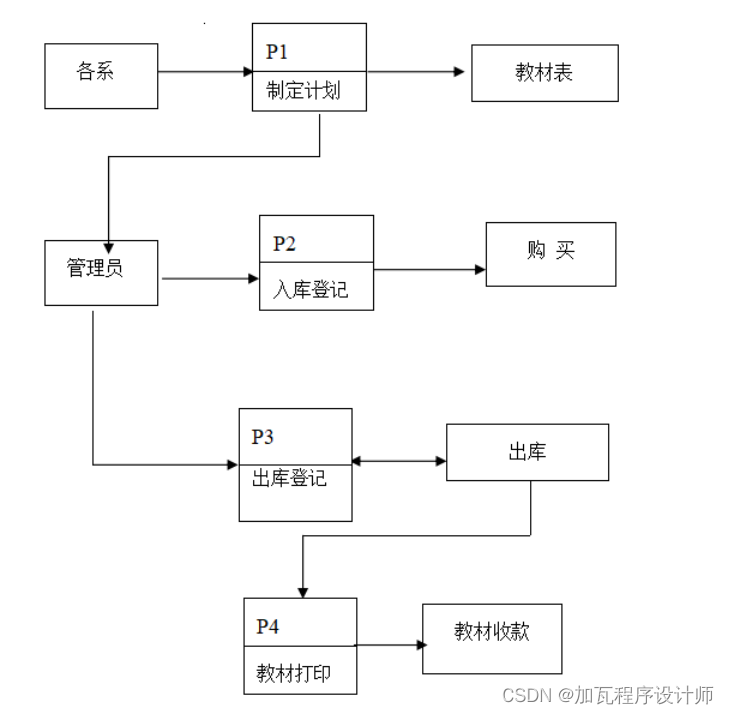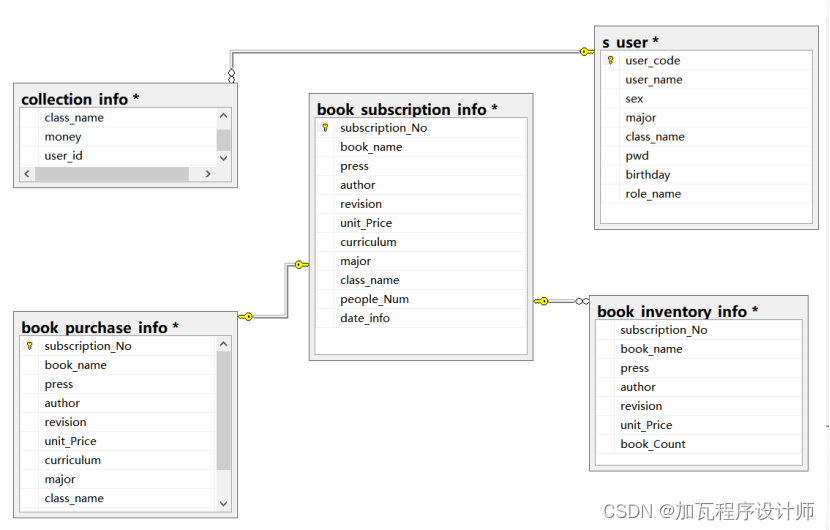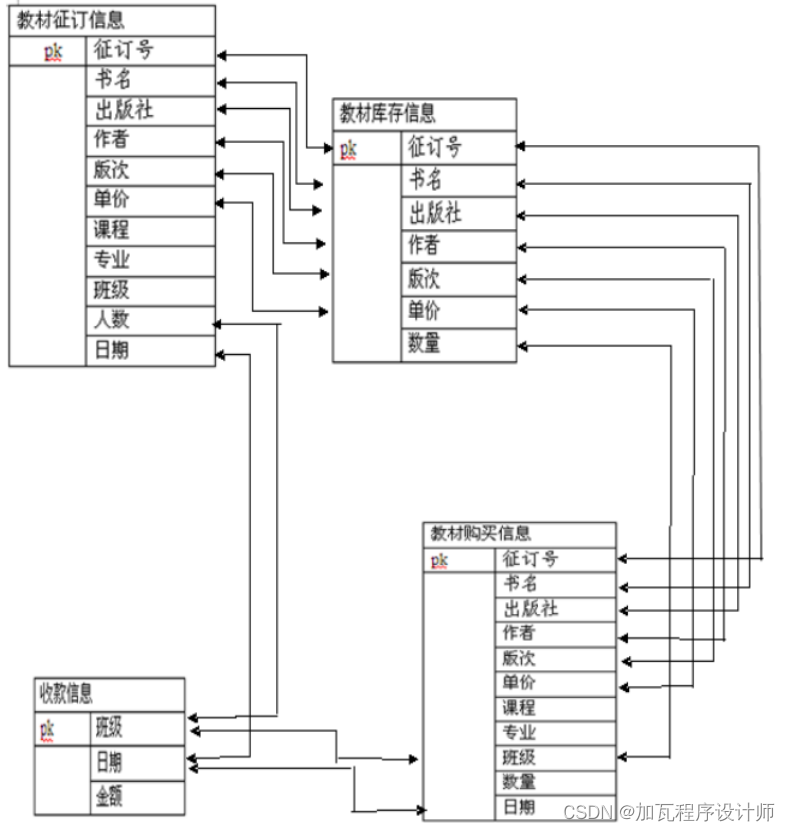Summary
With the rapid development of computers and the Internet, more and more industries have realized the informatization and automation of management, and the education industry is no exception. However, in many colleges and universities, the subscription of textbooks, as a very important link in the school teaching work, has not yet fully realized the information management. Therefore, aiming at the difficulties of manual management in the process of college textbook subscription management, this system uses SQLserver 2012 to develop a college textbook subscription management information system to realize the network management of textbook subscription, improve work efficiency, and reduce errors in textbook subscription.
The development of textbook subscription management system mainly includes the establishment and maintenance of database. This system requires the establishment of a library with strong data consistency and integrity and good data security, and requires the application program to be fully functional and easy to use. The system realizes functions such as subscription, purchase and distribution of multi-priced books, bibliographic replacement before arrival, a large number of input work, and bibliographic search.
Key words: textbook subscription database table design
1 System overview
The textbook subscription management system is an integral part of teaching management, and it is a typical information management system (MIS). The textbook subscription management mode of general schools is handled on the basis of the school year system and class as a unit. With the increasing number of students, the increasing diversification of teaching materials, and the increasing differences in teaching materials among individual students, the management of textbook subscription in colleges and universities has presented a situation that cannot be dealt with. Therefore, it is of great significance and urgency to establish a set of teaching material subscription management mode and management system matching with course selection, and the existing conditions, management concepts and technical level have made it possible.
In order to better adapt to the needs of current school management and avoid the disadvantages of manual management, a teaching material subscription management system has been developed, which can realize the automatic management of teaching material charging and receiving. This system includes four functions, namely, the storage management of teaching materials, Student's book fee management, system management and comprehensive inquiry.
2 Description of the problem
The textbook subscription management system is software that realizes basic functions such as system login and textbook information management. Through research and analysis of existing management models and existing management software, a system model is established. The system must realize functions such as basic information entry, modification, and query ; Realize the statistical analysis function that meets various conditions, and some statistical data should be presented in the form of charts. The textbook subscription management is fully responsible for all the textbook subscription information in the school. It is of positive significance to promote the automation and paperless management of school textbook subscription. The textbook subscription management system is designed for this situation.
The information involved is:
(1) Textbook subscription information. The data items included are: subscription number, book title, publisher, author, edition, unit price, course, major, class, number of people, date, etc.
(2) Teaching material inventory information. The data items included are: subscription number, book title, publisher, author, edition, unit price, quantity, etc.
(3) Textbook purchase information. The data items included are: subscription number, book title, publisher, author, edition, unit price, course, major, class, quantity, date, etc.
(4) Collection information. The data items included are: date, class, amount, etc.
(5) User information. The data items included are: user code, user name, password, birthday, category, etc.
The main function of this system consists of the following parts:
After research and analysis, the textbook subscription management system mainly completes the following functions:
(1) Basic user information module: basic information of users.
(2) Teaching material inventory information module: record the inventory quantity and basic information of teaching materials.
(3) Textbook Subscription Information Module: To inquire about the required textbook subscription information, that is, users can add, modify, delete, and query the subscription information.
(4) Textbook purchase information module: to query the required textbook purchase information, that is, the user adds, modifies, deletes, and inquires about subscription information.
(5) Receipt information module: information on recording the payment status of textbook purchases.
3 Demand Analysis
Requirements analysis is the basis of database design, and its mistakes will affect the entire design. Requirements analysis is also the most tedious and difficult stage for designers.
3.1 Data Flow Diagram
Data flow analysis is to abstract and isolate the flow of data within the organization, leaving out specific organizational structures, etc., in order to discover and solve problems in the data flow. After counting the demand for teaching materials, each department submits the teaching material order to the teaching material management department. The teaching material management department draws up a plan to generate a teaching material schedule, and submits the order form to the supplier in order to ask the supplier to supply the teaching materials and complete the purchase of teaching materials. After work, carry out storage registration, generate storage documents and submit them to the financial department for settlement. Each class will hand in the book list to the teaching material department, and the teaching material department will distribute the teaching materials to each class and register the delivery, generate a delivery list and submit it to the financial department for cost settlement, and generate a textbook cost list.
Its data flow chart is shown in the figure below

Figure 1 Data flow chart
3.2 Data Dictionary
Table 3-1 Data item description
| Data item name: textbook number |
| Brief description: store the information of each textbook |
| Brief Description: Coding of School Textbooks |
| Type and Length: Numeric, 7 digits |
| Data Value Type: (Continuous/Discrete) Discrete |
Table 3-2 Data structure description
| 数据结构名:教材管理表单 |
| 简述: 存储教材入出库等的表单 |
| 数据结构组成:征订号+书名+出版社+作者+版次+单价+课程+专业+班级+人数+日期+操作员 |
表3-3 数据处理描述
| 处理逻辑名:制定计划 |
| 加工编号:P1 |
| 简要描述:根据各系征订教材以及所缺教材定购计划。 |
| 输入数据流: 教材订单。 |
| 输出数据流: 教材计划表 |
表3-4 数据存储描述
| 数据存储名:入库教材 |
| 简述:存储入库教材的基本信息。 |
| 文件组成:征订号+书名+出版社+作者+版次+单价+数量。 |
| 数据存储名:出库教材 |
| 简述:存储出库教材的基本信息。 |
| 文件组成:征订号+书名+出版社+作者+版次+单价+数量。 |
| 数据流名:教材入库单 |
| 简述:存储入库教材的基本信息。 |
| 文件组成:征订号+书名+出版社+作者+版次+单价+数量。 |
表3-5 数据流描述
| 数据流名:教材出库单 |
| 简述:存储出库教材的基本信息。 |
| 文件组成:征订号+书名+出版社+作者+版次+单价+数量。 |
4 概念结构设计
4.1实体分析描述
从用户角度来说,数据库的需求主要体现在对数据库表的增删改查。因此,数据库结构需同时满足两个要素:输入、输出。在进行数据设计时,首先需收集数据,然后分析数据结构,最后处理数据。根据本系统的需求,设计以下主要的数据项和数据结构:
(1)用户信息实体:用户编号、姓名、性别、所属专业、班级、密码、出生年月、角色、类别。
(2)教材购买信息实体:征订号、书名、出版社、作者、版次、单价、课程、专业、班级、数量、日期。
(3)教材库存信息实体:征订号、书名、出版社、作者、版次、单价、数量。
(4)教材征订信息实体:征订号、书名、出版社、作者、版次、单价、课程、专业、班级、人数、日期。
(5)收款信息实体:日期、班级、金额。
4.2整体E-R图

图2 概念结构设计E-R图
5 逻辑结构设计
5.1 关系模式
关系模式:用户信息(用户编号、姓名、性别、所属专业、班级、密码、出生年月、角色)
模式判定:用户信息∈2NF,且每个非主属性都不传递函数依赖于用户信息的主关系键,所以用户信息∈3NF
关系模式:教材购买信息(征订号、书名、出版社、作者、版次、单价、课程、专业、班级、数量、日期)
模式判定:教材购买信息∈2NF,且每个非主属性都不传递函数依赖于教材购买信息的主关系键,所以教材购买信息∈3NF
关系模式:教材库存信息(征订号、书名、出版社、作者、版次、单价、数量)
Mode judgment: textbook inventory information ∈ 2NF, and each non-primary attribute does not transfer function depends on the primary relationship key of textbook inventory information, so textbook inventory information ∈ 3NF
Relationship model: textbook subscription information (subscription number, book title, publisher, author, edition, unit price, course, major, class, number of people, date)
Mode judgment: textbook subscription information ∈ 2NF, and each non-primary attribute does not transfer function depends on the primary relationship key of textbook subscription information, so textbook subscription information ∈ 3NF
Relationship mode: collection information (date, class, amount)
Mode judgment: payment information ∈ 2NF, and each non-primary attribute does not transfer function depends on the primary relationship key of payment information, so payment information ∈ 3NF
5.2 Data relationship diagram
As shown in the figure is the relationship diagram generated in the database.
 Figure 3 ER diagram of conceptual structure design
Figure 3 ER diagram of conceptual structure design
5.3 System relationship diagram

Figure 4 System Relationship Diagram
6 Physical structure design
6.1 Define the database and table name
Database name:
buybook
Database table name:
(1) User information table: s_user
(2) Textbook purchase information form: book_purchase_info
(3) Textbook inventory information table: book_inventory_info
(4) Textbook Subscription Information Form: book_subscription_info
(5) Collection information table: collection_info
6.2 Database storage structure design
In order to improve the performance of the system, according to the application situation, the variable part of the data and the stable part, often
The access part is stored separately from the infrequent access part.
Since today's computers have multiple disks, placing tables (such as user information tables) and indexes on different
In the query process, the efficiency of I/O read and write is greatly improved, and for larger partitions, the two
On a disk, it can speed up the access speed, and it is more effective in a multi-user environment; in order to improve the system
The performance of the log file and the database object (table, index, etc.) are placed on different disks. at the same time,
Considering that this system is multi-user, in order to improve efficiency, the data and log files of the database backup will be kept
stored on disk.
Frequently accessed parts of the database include:
User (user number, name, gender, major, class, password, date of birth, role)
Textbook subscription (subscription number, title, publisher, author, edition, unit price, course, major, class, number of people, date)
Inventory of textbooks (subscription number, title, publisher, author, edition, unit price, quantity)
Textbook purchase (subscription number, title, publisher, author, edition, unit price, course, major, class, quantity, date)
The infrequent access section includes:
Collection of teaching materials (date, class, amount)
In the initial stage of database design, in order to physically optimize the future database, some
The system configures variables, stores distribution coefficients, and assigns reasonable default values to these variables. but these values are not
It must be suitable for each application environment. When performing physical design, reassign these variables to improve
system performance. When choosing hardware devices, server operating systems, and databases, you should consider being able to gradually
Increase and expand.
When configuring system variables, pay attention to the number of users who use the database at the same time, the number of databases opened at the same time
Number of objects, memory allocation parameters, buffer allocation parameters, time slice size, database size, lock
number etc. These parameter values will affect the storage time of the database and the allocation of storage space.
6.3 Database table structure
Table 6-1 Textbook Purchase Information Form (book_purchase_info)
| field name |
Field Type |
length |
primary/foreign key |
Field Value Constraints |
Corresponding Chinese name |
| subscription_No |
varchar |
50 |
primary key |
Not null |
subscription number |
| book_name |
varchar |
50 |
Not null |
book title |
|
| press |
varchar |
50 |
Not null |
the publisher |
|
| author |
varchar |
50 |
Null |
author |
|
| revision |
varchar |
50 |
Not null |
Edition |
|
| unit_Price |
varchar |
50 |
Null |
unit price |
|
| curriculum |
varchar |
50 |
Null |
course |
|
| major |
varchar |
50 |
Null |
major |
|
| class_name |
varchar |
50 |
Null |
class |
|
| buy_Count |
char |
100 |
Not null |
quantity |
|
| buy_date |
Date |
Null |
date |
Table 6-2 Textbook Inventory Information Table (book_inventory_info)
| field name |
Field Type |
length |
primary/foreign key |
Field Value Constraints |
Corresponding Chinese name |
| subscription_No |
varchar |
50 |
primary key |
Not null |
subscription number |
| book_name |
varchar |
50 |
Not null |
book title |
|
| press |
varchar |
50 |
Not null |
the publisher |
|
| author |
varchar |
50 |
Null |
author |
|
| revision |
varchar |
50 |
Not null |
Edition |
|
| unit_Price |
varchar |
50 |
Null |
unit price |
|
| book_Count |
char |
100 |
Not null |
quantity |
Table 6-3 Textbook Subscription Information Form (book_subscription_info)
| field name |
Field Type |
length |
primary/foreign key |
Field Value Constraints |
Corresponding Chinese name |
| subscription_No |
varchar |
50 |
primary key |
Not null |
subscription number |
| book_name |
varchar |
50 |
Not null |
book title |
|
| press |
varchar |
50 |
Not null |
the publisher |
|
| author |
varchar |
50 |
Null |
author |
|
| revision |
varchar |
50 |
Not null |
Edition |
|
| unit_Price |
varchar |
50 |
Null |
unit price |
|
| curriculum |
varchar |
50 |
Null |
course |
|
| major |
varchar |
20 |
Null |
major |
|
| class_name |
varchar |
20 |
Null |
class |
|
| people_Num |
varchar |
20 |
Not null |
number of people |
|
| date_info |
date |
Null |
date |
Table 6-4 Collection information table (collection_info)
| field name |
Field Type |
length |
primary/foreign key |
Field Value Constraints |
Corresponding Chinese name |
| collection_date |
varchar |
Not null |
date |
||
| class_name |
varchar |
20 |
Not null |
class |
|
| money |
varchar |
10 |
Not null |
the amount |
Table 6-5 User information table (s_user)
| field name |
Field Type |
length |
primary/foreign key |
Field Value Constraints |
Corresponding Chinese name |
| user_code |
varchar |
50 |
host |
Not null |
user code |
| user_name |
varchar |
50 |
null |
username |
|
| sex |
varchar |
10 |
null |
gender |
|
| major |
varchar |
20 |
null |
major |
|
| class_name |
varchar |
20 |
null |
class |
|
| pwd |
varchar |
10 |
null |
password |
|
| birthday |
varchar |
30 |
null |
Birthday |
|
| role_name |
varchar |
30 |
null |
Phone number |
7 Database implementation
7.1 Database Creation
create database buybook
on
( name=work_data,
filename='d:\program files (x86)\sql\buybook.mdf',
size=5,
filegrowth=1
)
log on
( name=work_log,
filename='d:\program files (x86)\sql\buybook_log.ldf',
size=1,
maxsize=50,
filegrowth=10%
)
7.2 数据库表创建
(1)用户表
CREATE TABLE s_user (
user_code varchar (50) NOT NULL,
user_name varchar (50) NULL,
sex varchar (10) NULL,
major varchar (20) NULL,
class_name varchar (20) NULL,
pwd varchar (10) NULL,
birthday varchar (30) NULL,
role_name varchar (30) NULL,
CONSTRAINT PK_s_user PRIMARY KEY CLUSTERED
)
- 教材购买信息表
CREATE TABLE book_purchase_info (
subscription_No varchar (50) NOT NULL,
book_name varchar (50) NULL,
press varchar (50) NULL,
author varchar (50) NULL,
revision varchar (50) NULL,
unit_Price varchar (50) NULL,
curriculum varchar (50) NULL,
major varchar (50) NULL,
class_name varchar (50) NULL,
buy_Count varchar (50) NULL,
buy_date date NULL,
CONSTRAINT PK_book_purchase_info PRIMARY KEY CLUSTERED
)
- 教材库存信息表
CREATE TABLE book_inventory_info (
subscription_No varchar (50) NULL,
book_name varchar (50) NULL,
press varchar (50) NULL,
author varchar (50) NULL,
revision varchar (50 ) NULL,
unit_Price varchar (50) NULL,
book_Count char (100) NULL
)
- 教材征订信息表
CREATE TABLE book_subscription_info (
subscription_No varchar (50) NOT NULL,
book_name varchar (50) NULL,
press varchar (50) NULL,
author varchar (50) NULL,
revision varchar (50) NULL,
unit_Price varchar (50) NULL,
curriculum varchar (50) NULL,
major varchar (20) NULL,
class_name varchar (20) NULL,
people_Num varchar (20) NULL,
date_info date NULL,
CONSTRAINT PK_book_subscription_info PRIMARY KEY CLUSTERED
)
(5)用户信息表
CREATE TABLE s_user (
user_code varchar (50) NOT NULL,
user_name varchar (50) NULL,
sex varchar (10) NULL,
major varchar (20) NULL,
class_name varchar (20) NULL,
pwd varchar (10) NULL,
birthday varchar (30) NULL,
role_name varchar (30) NULL,
CONSTRAINT PK_s_user PRIMARY KEY CLUSTERED
)
7.3 建立存储过程
(1)建立用户表查询存储过程
create procedure s_user
as
begin
select b.用户编码,
b.用户名,
性别,
专业,
班级,
密码,
生日,
手机号
from 用户表 a
end
(2)建立教材购买信息表查询存储过程
create procedure book_purchase_info
as
begin
select b.征订号,
b.书名,
出版社,
作者,
版次,
单价,
课程,
专业,
班级,
数量,
日期
from 教材购买信息表 a
inner join 用户表 b on a.班级 = b.班级
end
(3)建立教材征订信息表更新存储过程
Create procedure book_subscription_info @班级 char(8), @记录号 int,
@姓名 char(30),@专业 char(10), @人数 char(10),
@日期 datetime
as
if not exists(select *
from 教材征订信息表
where 用户编码 = @用户编码)
Print ('不存在该用户')
else
begin
update 教材征订信息表
set 征订号=@征订号,
书名=@书名,
班级=@班级,
数量=@数量,
日期=@日期
where 用户编码 = @用户编码;
end
7.4创建触发器
(1) 创建一个触发器,当删除用户信息表时,时也删除其他表中用户的信息。如当删除用户表中信息时,也删除教材征订信息表中的内容,教材购买信息表,收款信息表分别建立此类触发器。
create trigger data_del
on 用户信息表
after delete
as
begin
delete 教材征订信息表
where 用户班级 in (select 用户班级 from deleted)
end
(2)建立教材购买信息触发器:
create trigger book_purchase_update
on 班级
after update
as
declare
@new_book_purchase_update int, @old_book_purchase_update int
select @old_book_purchase_update = deleted.征订号
from deleted
select @new_book_purchase_update= inserted.征订号
from inserted
if ((@new__book_purchase_update - @old__book_purchase_update) > @old__book_purchase_update * 0.15)
begin
raiserror ('教材购买过长,取消操作',16,1)
rollback transaction
end
(3)建立收款触发器:
CREATE TRIGGER collection_info
ON 用户信息表
AFTER INSERT
AS
BEGIN
SET NOCOUNT ON;
Declare @class int;
Select @class = 班级 From 用户信息表
IF (@class = null)
Begin
Insert into 用户信息表(员工编码, 用户名, 性别, 专业, 班级, 密码, 生日,手机号)
Select 员工编码, 用户名, 性别, 专业, 班级, 密码, 生日,手机号
From inserted
End
ELSE
Begin
print ('用户班级不存在')
rollback transaction
END